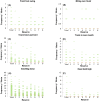Developing welfare parameters for African elephants (Loxodonta africana) in fenced reserves in South Africa
- PMID: 35324916
- PMCID: PMC8947097
- DOI: 10.1371/journal.pone.0264931
Developing welfare parameters for African elephants (Loxodonta africana) in fenced reserves in South Africa
Abstract
South Africa has many fenced reserves harbouring small to medium sized populations of African elephant (Loxodonta africana), most of which have been translocated. Elephants on fenced reserves may be exposed to various management interventions and practices (translocation, hunting, darting, high tourism impact, contraception programs, disruption due to infrastructure maintenance, etc.). These factors may impact the welfare of elephants. Poor elephant welfare may have serious consequences such as increased inter- and intra-species aggression that could result in fatalities. This is the first study to attempt to define behavioural and physiological welfare parameters for free-ranging elephants on small to medium sized reserves. The eight study sites incorporated reserves with different social structure combinations, elephant life-histories, reserve sizes, habitat, management, and tourism intensity. Data collection consisted of behavioural observations (10-minute videos) as well as faecal samples. By incorporating both behavioural and physiological (faecal glucocorticoid metabolite (fGCM) concentration) parameters, we aimed to investigate whether the two parameters showed similar trends. Five behavioural categories were identified (Arousal, Assessing, Ambivalent, Ambivalent/ Body care, and Frustrated behaviour), with various detailed behaviours demonstrated by the elephants that may indicate the influence of anthropogenic disturbance and possibly impact on animal welfare. The study showed significant differences between the selected detailed behaviours, behavioural categories and fGCM concentrations of elephants across the eight reserves. History seemed to be a decisive factor, as reserves with predominantly ex-captive elephants showed higher frequencies of certain behaviours as well as higher fGCM concentrations. Age, sex, reserve size and season were also found to contribute to our defined welfare indices and fGCM concentrations. This indicates that behavioural parameters, indicative of certain behavioural states, are valuable indicators of welfare, as supported by the physiological response of the elephants. The results also highlight the importance of taking multiple specified behaviours from a category into consideration when evaluating the welfare of elephants, to account for individual variation.
Conflict of interest statement
The authors have read the journal’s policy and have the following competing interests: TR and TE are employees of the Elephant Reintegration Trust. This does not alter our adherence to PLOS ONE policies on sharing data and materials.
Figures


Similar articles
-
Movement patterns of two reintegrated African elephant (Loxodonta africana) herds: transitioning from captivity to free-living.PeerJ. 2024 Jun 6;12:e17535. doi: 10.7717/peerj.17535. eCollection 2024. PeerJ. 2024. PMID: 38854797 Free PMC article.
-
Risk and ethical concerns of hunting male elephant: behavioural and physiological assays of the remaining elephants.PLoS One. 2008 Jun 18;3(6):e2417. doi: 10.1371/journal.pone.0002417. PLoS One. 2008. PMID: 18560517 Free PMC article.
-
Development of a behavioural welfare assessment tool for routine use with captive elephants.PLoS One. 2019 Feb 6;14(2):e0210783. doi: 10.1371/journal.pone.0210783. eCollection 2019. PLoS One. 2019. PMID: 30726232 Free PMC article.
-
Elephant Tourism in Thailand: A Review of Animal Welfare Practices and Needs.J Appl Anim Welf Sci. 2020 Apr-Jun;23(2):164-177. doi: 10.1080/10888705.2019.1569522. Epub 2019 Jan 28. J Appl Anim Welf Sci. 2020. PMID: 30689409 Review.
-
Update on Comparative Biology of Elephants: Factors Affecting Reproduction, Health and Welfare.Adv Exp Med Biol. 2019;1200:243-273. doi: 10.1007/978-3-030-23633-5_9. Adv Exp Med Biol. 2019. PMID: 31471800 Review.
Cited by
-
Anthropogenic impacts at the interface of animal spatial and social behaviour.Philos Trans R Soc Lond B Biol Sci. 2024 Oct 21;379(1912):20220527. doi: 10.1098/rstb.2022.0527. Epub 2024 Sep 4. Philos Trans R Soc Lond B Biol Sci. 2024. PMID: 39230457 Review.
-
Validation of a field-friendly faeces drying and storage method for quantifying faecal glucocorticoid metabolites in African elephants (Loxodonta africana) opens up new perspectives for conservationists.Conserv Physiol. 2023 Jul 31;11(1):coad053. doi: 10.1093/conphys/coad053. eCollection 2023. Conserv Physiol. 2023. PMID: 37538993 Free PMC article.
-
Movement patterns of two reintegrated African elephant (Loxodonta africana) herds: transitioning from captivity to free-living.PeerJ. 2024 Jun 6;12:e17535. doi: 10.7717/peerj.17535. eCollection 2024. PeerJ. 2024. PMID: 38854797 Free PMC article.
References
-
- Pretorius Y, Garaï ME, Bates LA. The status of African elephant Loxodonta africana populations in South Africa. Oryx. 2019;53 (4): 757–763. doi: 10.1017/S0030605317001454 - DOI
-
- Scholes RJ, Mennell KG. Elephant management: A Scientific Assessment for South Africa. Johannesburg: Wits University Press; 2008.
-
- IUCN. Assessment Report Loxdonta cyclotis. IUCN Species Information Service (SIS) Toolkit Assessment report, 2021. Available: https://sis.iucnsis.org/apps/org.iucn.sis.server.extensions.reports/repo...
-
- IUCN. Assessment report Loxdonta africana. IUCN Species Information Service (SIS) Toolkit Assessment report, 2021. Available: https://sis.iucnsis.org/apps/org.iucn.sis.server.extensions.reports/repo...
Publication types
MeSH terms
LinkOut - more resources
Full Text Sources

